[ad_1]

Imagine every penny you earned for nearly 10 months out of the year went toward paying off a single purchase. For millions of Americans, that’s a reality, as it now takes more than 41 weeks of income to purchase a new light vehicle, per data from the Cox Automotive/Moody’s Analytics Vehicle Affordability Index. Further, as of May, the estimated typical monthly payment for a new vehicle reached a record high of $712. June’s numbers will be released on July 15.
Additional data from Edmunds shows that some households are willing to push their budgets even further, with almost 13% of consumers who financed a new vehicle committing to a monthly payment that exceeds $1,000. That’s also a record high, and up significantly from years past—only 2.1% of car buyers agreed to payments that much in June 2010, and only 4.6% did so in June 2019.
Even with prices high and quality falling, we should probably expect to see the auto market to continue racing along in the months ahead.
“The majority of consumers who are purchasing vehicles in these conditions are either in a financial position where money is less of a consideration or are doing so out of absolute necessity,” said Jessica Caldwell, executive director of insights at Edmunds, in a statement. “Looking ahead, a recovery in vehicle production in 2022 seems highly unlikely at this point, but a bright spot for the industry is that profit margins are staying high and pent-up consumer demand will only continue to build as shortages continue.”
With the median household income in the United States amounting to around $67,500, a monthly car payment of $1,000—or even $700—can quickly eat up a significant portion of a family’s budget. Even so, buyers appear undeterred, as they’re evidently willing to spend more and more on a new car. This, despite rising interest rates that make auto loans more expensive, and the prospect (or likelihood) of the economy entering a recession.
It’s possible that buyers feel they have little choice, though, as their willingness to commit to a higher monthly payment has marched in tandem with car prices, which also have increased by thousands of dollars over the past couple of years. As of May, the average new vehicle cost more than $47,000, whereas, in 2018, prices were around $38,000.
Headwinds on the windshield
Vehicle prices are one of the areas that have been hit the hardest by inflation as a shortage of materials and components like semiconductors, caused by supply-chain issues, created a logjam in the number of new cars hitting dealers’ lots.
Fewer available cars led to higher prices, and rising car prices have been a major contributor to overall rising inflation levels. The latest Consumer Price Index data from May, which showed overall inflation at 8.5% year-over-year, also showed that new vehicle prices were up 1% month-over-month, and up 12.6% year-over-year. Prices for used cars and trucks were up more than 16% year-over-year.
With that in mind, perhaps consumers who are taking on larger car payments simply have no other options, given that consumer tastes have gravitated toward bigger, pricier trucks and SUVs. But, add in increasing gas prices, and it’s a wonder how long American drivers, already paying more and more for just about everything in a high-inflation environment, will be able to keep up with relatively high payments.
Interestingly enough, as prices increase, the quality of vehicles sold appears to be decreasing. Almost every car brand saw a spike in the number of complaints in 2022 than they did a year ago—a sign of potential quality falling across the board, according to the 2022 J.D. Power Initial Quality Study, released late last month. There are some reasons for that, which also concern increasing vehicle prices—notably, more complex technology and features (infotainment systems, driving assistance, etc.) still have kinks to be worked out, and that also adds to manufacturers’ costs.
“Given the many challenges automakers and their dealers had to face in the past year, it’s somewhat surprising that initial quality didn’t fall even more dramatically,” said David Amodeo, director of global automotive at J.D. Power, in a press release.
[ad_2]
Source link

